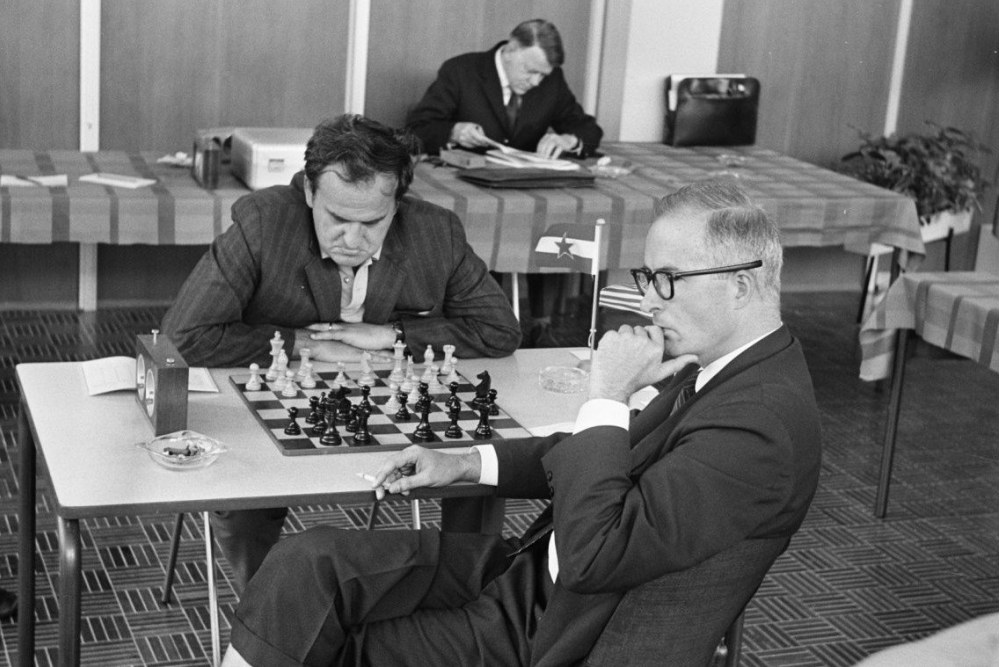A chess pro at 40
Robert Byrne was born in New York on April 20, 1928. He is the older brother of Donald Byrne (1930-1976), also a strong grandmaster, known for his defeat in Fischer's "game of the century". He died early in 1976, aged 45, as a result of autoimmune disease. Both Byrne brothers were in their active time to the best chess players in the United States.
Robert and Donald Byrne grew up in New York City and belonged to the chess group of legendary chess teacher John William Collins. Robert Fischer was also looked after by Collins.
At age 17, Robert Byrne played his first chess tournament in Ventnor City (1945). After graduation, however, he focused on his studies and then became a philosophy professor at Indiana University. He participated in tournaments only sporadically. Nevertheless, he rose in later years quite quickly to become one of the best players in the United States.
In 1950, Byrne was on the USA team in the famous radio match against Yugoslavia, in which he drew twice against Boris Kostic. In 1951 he participated in the Wertheim Memorial in New York and finished tied for 6th-7th in a strong field. Reshevsky won ahead of Najdorf and Euwe. In 1952 Byrne represented the USA for the first time at the Chess Olympiad in Helsinki and scored the third best single result (bronze medal) on the third board. His victory over David Bronstein in the 2:2 result against the USSR team caused a stir and he made a name for himself in one fell swoop. Throughout his career, Robert Byrne participated in eight other chess Olympiads, including the bronze medal winning team in 1974, silver in 1960 and 1966 and gold in 1976 in Haifa (absent teams of the Eastern Bloc, including the USSR team).
Byrne began to compete regularly in the US Championships only at the age of 30. At the 1958 US Championships in New York Byrne finished ninth. The title was won by Fischer. In 1959 Byrne was second behind Fischer. In the following years, he was a regular participant in the US championships and was able to repeat his runner-up performance in 1961, 1965 and 1977. In 1972 and 1973, he won the national title on tiebreak.
Fischer included his game against Robert Byrne in the 1963 US Championship in his famous book "My 60 Memorable Games". The game was played on December 18th, 55 years ago today:
This was the legendary US Championship in which Fischer won with a perfect 11 out of 11. Byrne retaliated two years later at the US Championships in 1965, however, when he punished Fischer's carelessness:
This was the only time Byrne managed to defeat Fischer. At the same championship Byrne also managed a brilliant attack victory against Larry Evans in the Poisoned Pawn variation of the Sicilian:
Notwithstanding this furious tactical spectacle, Byrne was considered a solid positional player, a champion of prophylaxis, and particularly strong in the endgame.
Among Byrne's successes in international tournaments, was second place at Mar del Plata 1961 behind Miguel Najdorf, a third place at the Buenos Aires International in 1964 behind Paul Keres and Tigran Petrosian and a shared third place with Robert Hübner in Las Palmas 1976. In 1964, he shared first place at the USA Open in Seattle with Pal Benkö.
Byrne's biggest international success, however, was the third place in the interzonal tournament in Leningrad in 1973 behind Victor Korchnoi and Anatoly Karpov. He qualified as the fourth American after Reshevsky, Fischer and Benkö, for the candidate tournament, but was beaten n the quarterfinals of 1974 by Boris Spassky.

Byrne-Spassky | Photo: Byrne family archive
In July 1973, Byrne reached 12th place in the FIDE world ranking together with Efim Geller and Leonid Stein.
For 34 years, from October 1972 to 2006 without interruption, Robert Byrne was in charge of the weekly New York Times chess column. In his obituary of 2013, Lubomir Kavalek recounts how Byrne was always on at tournaments with a typewriter and relayed his columns for the Times via a mobile telegraph. Byrne said goodbye to his readers in 2006, his last column on his famous game against Bronstein at the 1952 Chess Olympiad.
Robert Byrne, as well as his brother Donald, were characterised by a fine sense of humour. Before his candidates contest against Spassky in 1974, he was asked by a journalist which openings would come up on the board: Byrne replied: "I wish I knew." "But will you play 1.e4 with White?" insisted the journalist. "Spassky wished he knew," Byrne answered.
Robert Byrne died on April 13th, 2013 at the age of 84, having previously suffered from Parkinson's for many years.
Links
























